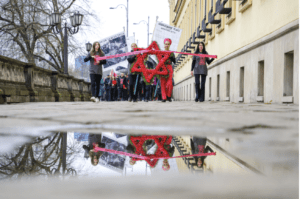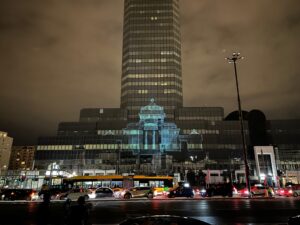First published in the Spring 2023 issue of Searchlight magazine
 16th April 2023 commemorative march led by women activists
16th April 2023 commemorative march led by women activists
photo by David Rosenberg
Warsaw, Sunday 16 April. Three days before the Polish Government is due to host the official 80th anniversary commemoration of the Warsaw Ghetto Uprising, when their chosen guests will assemble in front of a stark, powerful monument, designed by Nathan Rappaport, a Warsaw-born Jew who survived the war in the Soviet Union. The monument depicts the heroism of the ghetto fighters in the midst of their incredible uprising against the Nazis that lasted nearly a month.
With few weapons, hundreds of starved combatants, the youngest just 13 years old, fought a courageous but doomed guerrilla war against the might of the German army who were determined to destroy the ghetto, building by building, and murder or deport its remaining inhabitants to death camps. Ironically, the materials used for the Uprising monument were procured from Scandinavia by the Nazi Albert Speer for a planned victory monument.

Ghetto Heroes Monument: photo by David Rosenberg
The current Polish Government of PiS (Law and Justice) is one of the most right-wing nationalist regimes in Europe. Its harsh attitudes to minorities, especially towards non-white, non-Christian refugees seeking sanctuary on Poland’s border with Belarus, its closeness to Victor Orban’s reactionary government in Hungary, its disdain for women’s rights and LGBT rights, its persecution of Jewish historians who reveal uncomfortable truths from Poland’s past, make PiS particularly unfit to claim ownership of the ghetto fighters’ struggle. For the resisters it was a fight for dignity and freedom in a world of humanity.
Small wonder then, that alternative events were created to give broader and truer meanings to the ghetto inhabitants’ struggles. Though Poland’s current government would deny it, the troubles for Jews in Poland began several years before the Nazis invasion. Jews and their allies were physically combating Poland’s homegrown Catholic-nationalist far-right through the 1930s, especially after the Przytyk pogrom in March 1936. In that decade Jews comprised 10% of the entire Polish population and 25% of its trade unionists. In Warsaw, one in three of its inhabitants were Jews.
An alternative event on 16 April this year literally revealed other dimensions to this history. It focused on the reverse side of Rappaport’s monument, a bas-relief, which, instead of resistance depicts Jewish victims, heads bowed, being corralled by Nazis towards the Umschlagplatz, the point of deportation to death camps. The victims were cynically told they were being relocated for work.
And yet, up to the moment when they were forcibly deported, the civilian population had found imaginative collective ways to survive the harshest and cruellest treatment by their occupiers, their tormentors, their oppressors. They engaged in quiet but crucial forms of daily resistance, undetected by the Nazis – supporting neighbours with problems, creating underground soup kitchens and welfare projects, maintaining underground schools, organising music, drama and poetry performances, and sharing news through underground newspapers.
On 16 April, after a march through Muranow, an important Jewish district before and during the ghetto times, the bas-relief was symbolically unveiled. A group of women led the march, holding a floral wreath – a 6-pointed Jewish Star with ribbons celebrating the “everyday heroism” of survival in the ghetto printed in Yiddish and Polish. Many participants carried colourful flags with Jewish symbols.
As we reached the monument’s reverse side, the Krakow Revolutionary Choir greeted us with Yiddish songs of the Bund – the Jewish workers movement that played such a key role in tackling far-right antisemitic forces in 1930s Poland. The Bund later formed a crucial component of the Jewish Combat organisation, created in October 1942, together with communist and Zionist groups. A young Bundist, Marek Edelman, Second in Command of the Uprising, chronicled it in The Ghetto Fights, a remarkable book published in Polish in 1945, and translated into Yiddish and English in 1946.
The keynote speaker on 16 April was Zuzanna Hertzberg, a Warsaw-born Jewish artist, active today in women’s rights and anti-fascist campaigning. Her grandfather fought in the Botwin company, Dabrowski Batallion, in the Spanish Civil War – a unit comprised largely of Polish Jews, named after a Jewish communist executed in 1926 for murdering an agent of the Polish secret police.
Through the anniversary week, Hertzberg delivered a series of spoken word performances in English and Polish, in Warsaw’s Palace of Culture. One focused on Jewish women resisters during the Holocaust; the other highlighted Jewish women’s participation in the Spanish Civil War. Our delegation of seven Jewish socialists from London watched both. Using photos and clippings from her archive research interspersed with her own artistic responses on canvas, Hertzberg conveyed moving and hitherto obscured stories of real women’s lives.
The actual anniversary of the day in 1943 when resistance fighters fired their first shots and threw their first Molotov cocktails at the Nazis who had come to liquidate the ghetto was 19 April.
The official commemoration gathered in front of the Rappaport monument behind a temporary security wall. With three presidents in attendance, snipers were poised on nearby rooftops. At midday, a siren sounded. Hundreds of us, who had no wish to be associated with the hypocritical official ceremony, gathered for a “grassroots commemoration” some 200 yards away at a very poignant memorial for a Polish Jewish socialist and anti-fascist, Szmul Zygielbojm who committed suicide in London on hearing that the ghetto revolt had been crushed.
A sculpture symbolising a shattered world stands before a darkened window etched with human shapes, smoke rising around them, and a quote from Zygielbojm in Yiddish and Polish: “I cannot be silent and I cannot live while the remaining Jews in Poland are being exterminated.” This disturbing memorial was not an initiative of the Polish State but funded through personal donations, internationally, encouraged by Marek Edelman.
After an open act of anti-Nazi defiance, Zygielbojm was hidden, then smuggled out of Warsaw in January 1940 with a crucial mission to lobby and mobilise Western powers to undertake extraordinary actions to assist and offer sanctuary to Poland’s Jews. After a perilous journey across Nazi Germany, he reached Belgium and gave a shocking first-hand report of the brutality the Nazis were inflicting on Jews in occupied Poland. He sent on to politicians, diplomats and the press the updates he received through underground resistance networks describing the escalating crimes against the Jews, including mass murder by poison gas.
From late March 1942 to May 1943 he represented the Bund on the National Council of the Polish Government in Exile in London. On 11 May, after hearing that the uprising had been crushed, he committed suicide at his flat, leaving a set of letters making clear that this was an act of protest against the Allied powers who had not done enough to save Jewish lives.
By the Zygielbojm monument a choir from a humanist school in Warsaw which promotes multiculturalism and internationalism, sang Yiddish Bundist songs. Extracts were read in Polish from Marek Edelman’s memoirs. I was asked by Paula Sawicka, from the Open Republic Association against Antisemitism and Xenophobia (Otwarta Rzeczpospolita), to read English translations of these. Sawicka says it was Edelman who originally inspired these grassroots commemorations, by coming privately to the memorial route, “accompanied by a growing group of friends who understood the need for remembrance, less official and more personal… a spontaneous gesture that had no organizer and still does not. Everything is done by volunteers. People need a signal and Open Republic gives it.”
We marched from Zygielbojm’s shattered world, to the memorials at Miła 18, where, in the final days of the uprising, most of the surviving resisters were trapped in a bunker completely surrounded by Nazis. Most killed themselves rather than let the Nazis murder them. A 40-strong segment of the fighters, Edelman among them, chose the only alternative – to attempt an escape from the ghetto via the sewers. The majority succeeded. More speeches were made at Miła 18 and the young choir sang the Yiddish Hymn of the Partisans, Zog Nisht Keyn Mol (Never say you are going down the last road).
Our final destination was the Umschlagplatz memorial, where scores of first names of the victims are etched, representing the hundreds of thousands deported to death from here. I read more translated extracts from Edelman, specifically about the Umschlagplatz, and others read short tributes to individual children who had been deported from there.

Projection of the Great Synagogue – photo by David Rosenberg
On the evening of !9 April, a dramatic multimedia projection made by the Polish-born artist/film-maker Gabi von Seltmann (whose grandfather perished in Auschwitz) had its third showing. It was first shown on the Ghetto Uprising’s 75th anniversary in 2018.
On 16 May 1943, the Nazis destroyed the Great Synagogue of Warsaw that stood on Tlomackie Street, and SS commander Jürgen Stroop reported to Hitler that Warsaw was now “judenfrei” – Jew-free. Warsaw’s cathedral was rebuilt after the war, the Great Synagogue was not. More recently the Blue Skyscraper was constructed on the site.
All lights in the building were turned off before 9pm. For two hours the 6-minute projection played on a loop. Archived recordings of the pre-war synagogue cantor could be heard as a life-size image of the synagogue appeared on the building, as if rising from the ruins. Above the synagogue projection, was one Yiddish word: “libe” – “love”. The show ended with a recording by Irena Klepfisz of her haunting poem “Bashert” (Fate) in English. Today Klepfisz lives in New York. She was born in the Warsaw Ghetto in 1941. Her father, Michal, was killed on the second day of the Ghetto Uprising, aged 30.
The final event during our week-long visit was a guided walk led by Paula Sawicka of Open Republic, through the rebuilt ghetto area, revealing traces of Marek Edelman and Michal Klepfisz at locations significant to them. Sawicka discovered these places at firsthand from Edelman. She wants to help “restore the memory of the destroyed Jewish world to the city’s consciousness” and spread awareness that “when we walk along the wide, bright and green streets,” once within the ghetto, “we are walking on graves”.
On the walk, we stopped by a school building with a mural of Edelman on its side wall, with a quote as much for our own times as his: “Nienawiść jest latwa. Miłość wymaga wysiłku i poświęcenia”. Hate is easy. Love requires effort and sacrifice.
We were so privileged to spend the week with inspirational anti-racist and anti-fascist counterparts in Warsaw committed to the fight against hate and discrimination in 2023.
